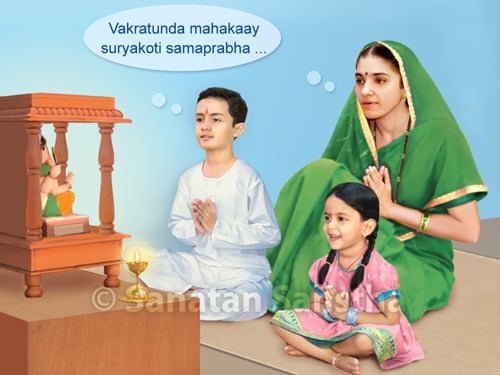
This article gives details of various mantras associated with Shri Ganapati and spiritual benefit obtained through recitation of these mantras.
1. Mantra for spiritual practice
A. ‘Shri Ganeshaya Namaha (श्री गणेशाय नमः ।)’
Here, ‘Shri’ means ‘Shrim’ which is the bij-mantra (Basic monosyllabic mantra). ‘Ganeshaya’ is the concept of the bij (Root) while ‘Namaha’ is the pallav (Salutation).
B. ‘Om Gan Ganapataye Namaha (ॐ गँ गणपतये नमः ।)’
Meaning : ‘Om’ is the ‘pranav’ (The sacred syllable), ‘Gan’ the bij-mantra, ‘Ganapataye’ the figure and ‘Namaha’ means ‘I offer obeisance’
2. Bij-mantra
Gan (गँ)’ is the bij-mantra of Ganapati. The energy group from which Shri Ganapati (meaning the energy flows in the five Cosmic Principles) originated is incorporated in the bij-mantra ‘Gan’. The pronunciation of ‘Gan’ is the product of the blending of the five nasal consonants nha (ङ), yan (ञ), na (ण), na (न) and ma (म).
Hence, its pronunciation is not ‘gam’ but ga (ग) + (ङ) = ‘Gan’.
In this connection, the Atharvashirsha mentions –
गणादिम् पूर्वमुच्चार्य वर्णादिन् तदनन्तरम् ।
अनुस्वारः परतरः । अर्धेन्दुलसितम् ।
तारेण ऋद्धम् । एतत्तव मनुस्वरूपम् ।
गकारः पूर्वरूपम् । अकारो मध्यमरूपम् ।
अनुस्वारश्चान्त्यरूपम् । बिन्दुरुत्तररूपम् ।
नादः सन्धानम् । संहिता सन्धिः ।
Meaning : (It is stated here how to pronounce the bij-mantra ‘Gan [गँ]’) First of all, we should pronounce ga from the word gana; thereafter we should pronounce the first sound ‘a’; then we should pronounce the dot above the letter (the nasal sound). This ‘Gan (गँ)’ should include ‘Om’. (This means, Om has to be pronounced first and then the mantra ‘Gan’). This is your mantra form. The sound created by the pronunciation of ga in the beginning, ‘a’ in the middle and lastly the sound generated by the dot is known as samhita sandhi. This itself is the Ganeshvidya, that is, the science of writing and pronouncing the bij-mantra Gan (गँ).
A. Effect of repetition of ‘Gan’
Effect of repetition of ‘Gan’ on the root of mandar (Coral) tree : Upon chanting of ‘Gan’ in front of the white mandar tree, a root of that tree springs up. It is shaped like Shri Ganesh’s form. The reason for this is, that chanting of ‘Gan’ creates its waves in the atmosphere. This has an effect on the roots of the tree and according to the law that ‘Word, touch, form, taste, fragrance and their energies coexist’, with the generation of the energy of ‘Gan’, a root shaped like Shri Ganesh springs up. If a white mandar tree that is more than 7 or 8 years old is uprooted, we will find that the shape of its root resembles Shri Ganapati.
On Angarakyog or on a Sunday when the Pushya lunar asterism is present, perform Shoḍashopachar-puja of a tree (which is more than seven or eight years old) and recite the Shri Ganapati Atharvashirsh. Generally, beginning from the Chaturthi of one fortnight to the next, approximately one thousand recitations should be completed. Then modak, parched corn and durva blades, each a hundred in number, should be offered as oblation in a sacrificial fire. Finally, without speaking to anyone or touching anyone, the tree should be uprooted. Its form will resemble Shri Ganapati. This sanctified Idol should then be installed in the house. The Idol should be worshipped daily with frankincense, a lit lamp and offered Naivedya along with the recitation of the Atharvashirsha. Often such an Idol is kept covered to prevent the loss of its energy.
Chanting of the mantra ‘Gan’ over a flint stone from salt water for at least a year results in the stone acquiring the form of Shri Ganapati. Moraya Gosavi, a great devotee of Shri Ganesh created several such Ganapati Idols.
B. Ganeshavidya
The Indian science of writing based on phonetics : In the Holy hymn ‘Shri Ganapati Atharvashirsha’, the bij-mantra ‘Gan’ is used in reference to correct writing.
‘गँ’ (Gan) is the bij-mantra of Shri Ganapati. The letter ‘Gan’ in the mantra represents the nirgun (Non-materialised) form of God, whereas the letters ‘Ganapataye’ represent sagun (Materialised) form of God.
3. Atharvashirsha
‘Tharva’ means hot, ‘atharva’ means Shanti (Peace) and ‘shirsha’ means the head. Thus Atharvashirsha is that by recitation of which one acquires peace. Sage Mudgal, the disciple of Sage Bhagavan Jaimini from the Samaveda branch, wrote the ‘Sammudgal Ganeshsukta’. Thereafter, Sage Mudgal’s disciple, Sage Ganak, wrote the Ganapati Atharvashirsha. In most mantras, contemplation of the Deity, that is, description of its Idol precedes its praise. However, it is the reverse in the Atharvashirsha.
The three main parts of the Atharvashirsh are –
1. Shantimantra
The mantras, ‘ॐ भद्रं कर्णेभि :’ and ‘स्वस्तिनः इंद्रा….’ at the beginning, and the mantra, ‘सह नाववतु ।….’ at the end.
2. Dhyanvidhi (Ritual of meditation)
The ten mantras from ‘ॐ नमस्ते गणपतये’ o ‘वरदमूर्तये नमः’.
3. Phalashruti (Benefits)
The four mantras from ‘एतदथर्वशीर्ष योऽधीते’.
A. Recitation of the Atharvashirsha
When reciting this Holy hymn, pay attention to the following suggestions.
-
The pronunciation should be very clear.
-
The recitation should be low and at a steady pace.
-
Recitation should be done by understanding the meaning and with bhav (Spiritual emotion). The pronunciation should not be mechanical. Rather, it should be such that the individual reciting it gets endowed with bhav for God and Shakti (Divine Energy).
-
When the hymn is to be recited more than once, it should be recited only upto ‘Varadamurtaye Namaha (वरदमूर्तये नमः ।)’. The recitation of the phalashruti should be done only after the last recitation. Similarly, the shantimantra should be recited only once in the beginning, instead of at the beginning of each recitation.
-
Twenty-one rounds of this hymn are equivalent to one abhishek.
-
Bathe before reciting the hymn.
-
Instead of a wooden seat, use a folded washed cloth, deerskin, woollen blanket or a mat made of darbha as seat.
-
Adopt a simple cross-legged sitting posture so that the posture will not be required to be changed till the entire recitation is complete.
-
Sit facing any direction, except the south.
-
Sit with the posture erect.
-
Before commencing the recitation, pay obeisance to parents and the Guru.
-
If possible, worship Shri Ganapati and offer akshata, durva, shami (Mesquite) leaves and red flowers to Him. If ritualistic worship is not possible, then we should at least meditate on Him for a minute, pay obeisance and then begin the recitation.
-
To avoid mistakes in pronunciation, learn it from someone who is well-versed in it.
-
Recite by looking at the Idol of Ganapati or Om (ॐ) as it facilitates in achieving concentration faster.
B. Benefits of reciting the Atharvashirsha
-
The benefits of reciting a hymn are given in the hymn itself. Since this literature is a result of inspiration through the para mode of speech to the Sages who are ‘atmadnyansampanna’ and contains their sankalpa (Resolve), those who recite it get the benefit.
-
The hymn has the ability of creating a protective sheath around the reciter. Hence, recitation of the Atharvashirsha protects us from the distress due to negative energies.
4. Ganesh Gayatri
एकदन्ताय विद्महे । वक्रतुण्डाय धीमहि । तन्नो दन्तीः प्रचोदयात ।।
Meaning : We are familiar with Ganapati who has only one tusk. We contemplate on Vakratunḍa (Ganapati). May that Ganapati (danti) inspire our intellect benevolently.
Reference : Sanatan Sanstha’s Holy text ‘Shri Ganapati’.

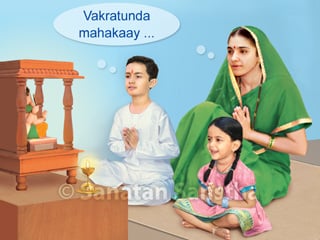
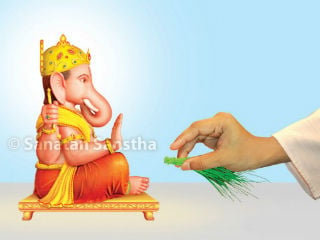 Significance of offering durva to Shri Ganapati
Significance of offering durva to Shri Ganapati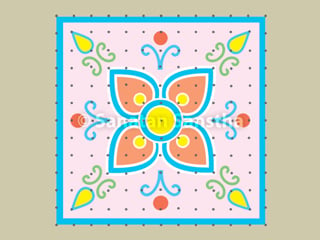 Shri Ganesh Rangoli - Rangoli designs associated with Shri Ganesh Principle
Shri Ganesh Rangoli - Rangoli designs associated with Shri Ganesh Principle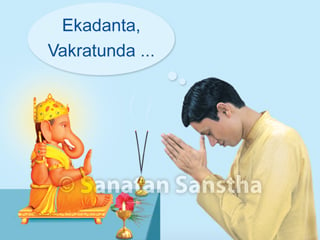 Meaning of some Shri Ganesh Names
Meaning of some Shri Ganesh Names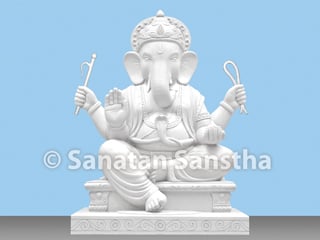 Ganesh Avatars as per Eras (Incarnations of Shri Ganapati)
Ganesh Avatars as per Eras (Incarnations of Shri Ganapati)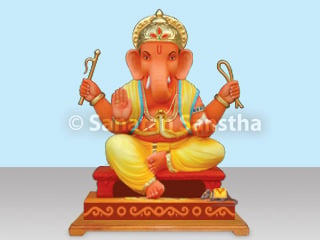 Variations in the Idol of Shri Ganesh
Variations in the Idol of Shri Ganesh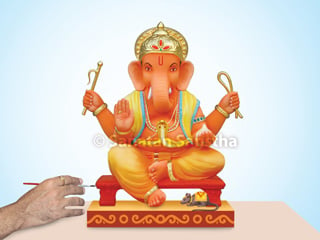 What is the ideal way of making Shri Ganesh Murti (Idol of Shri Ganapati) ?
What is the ideal way of making Shri Ganesh Murti (Idol of Shri Ganapati) ?